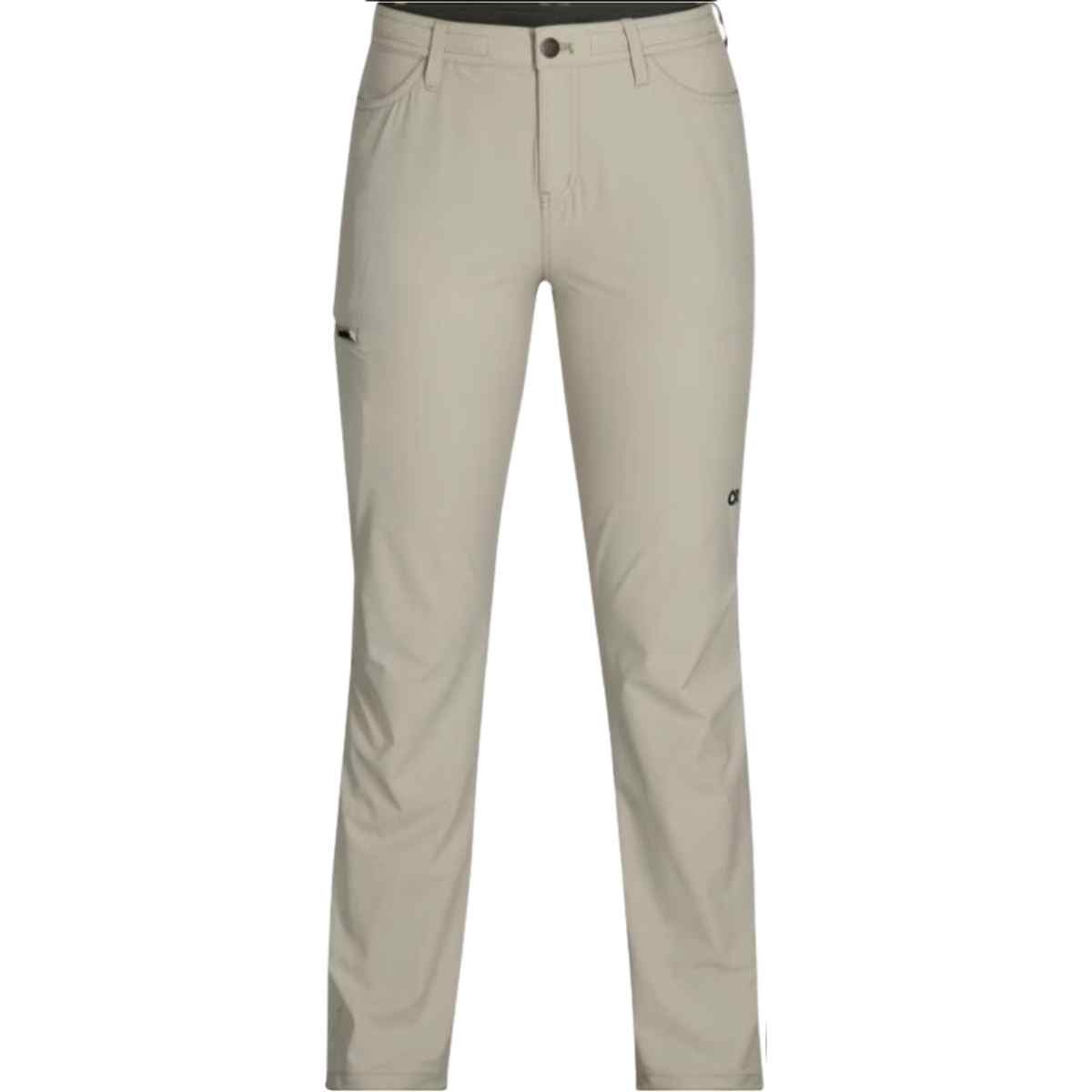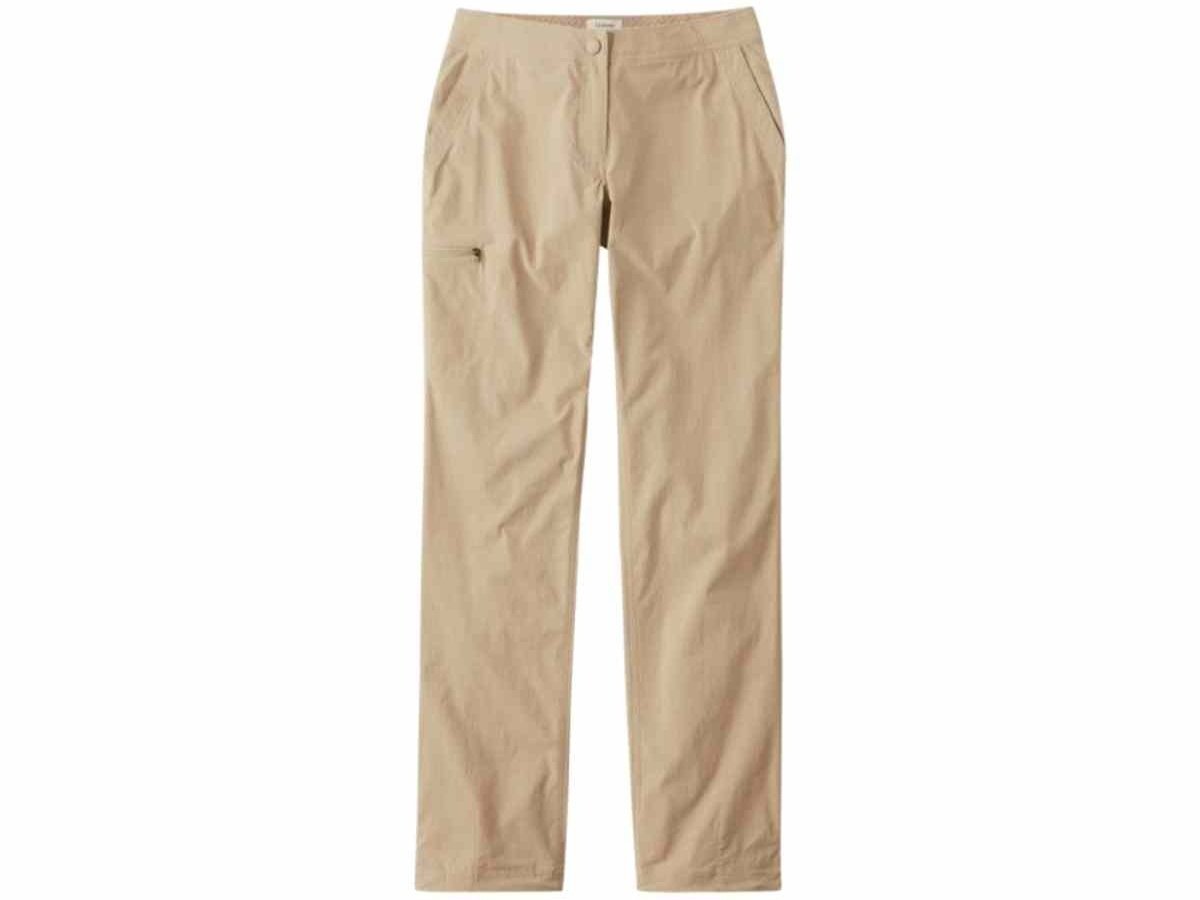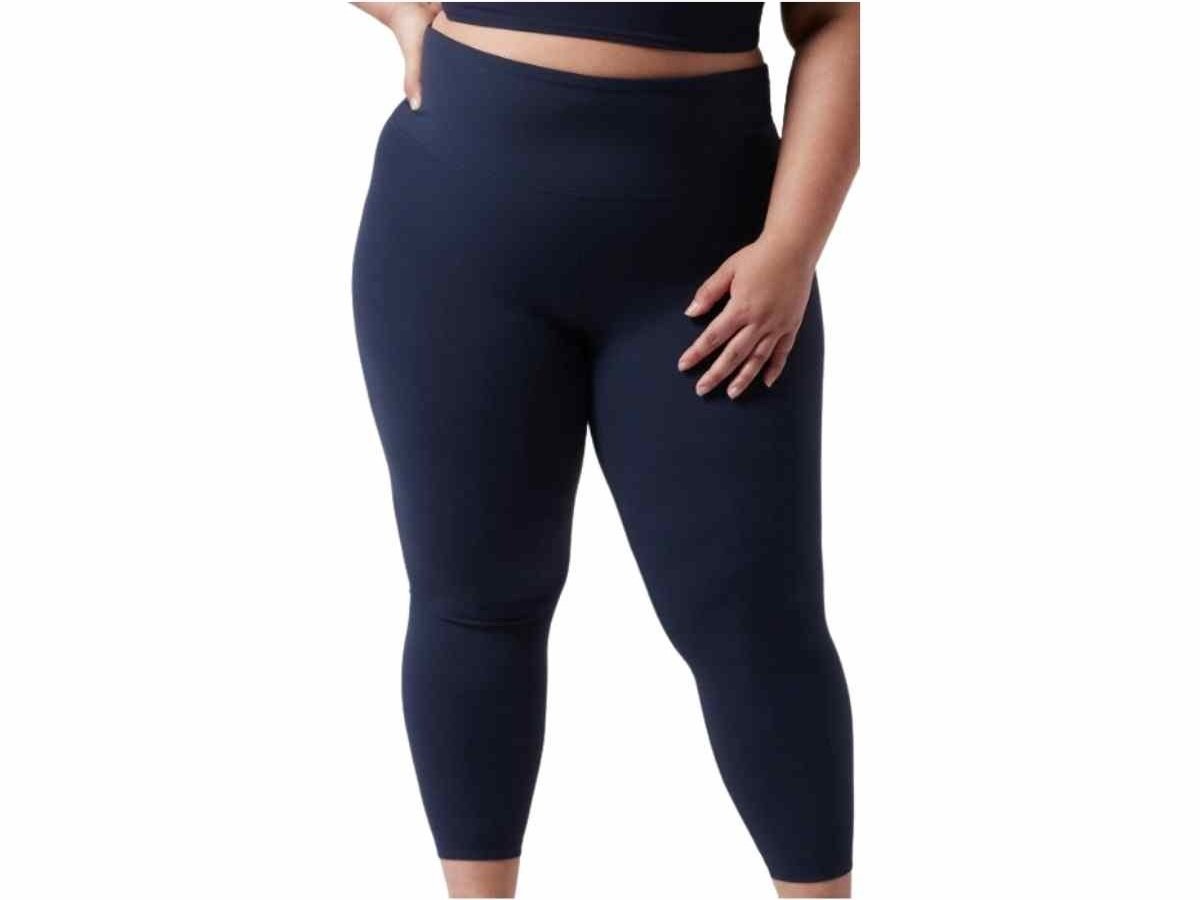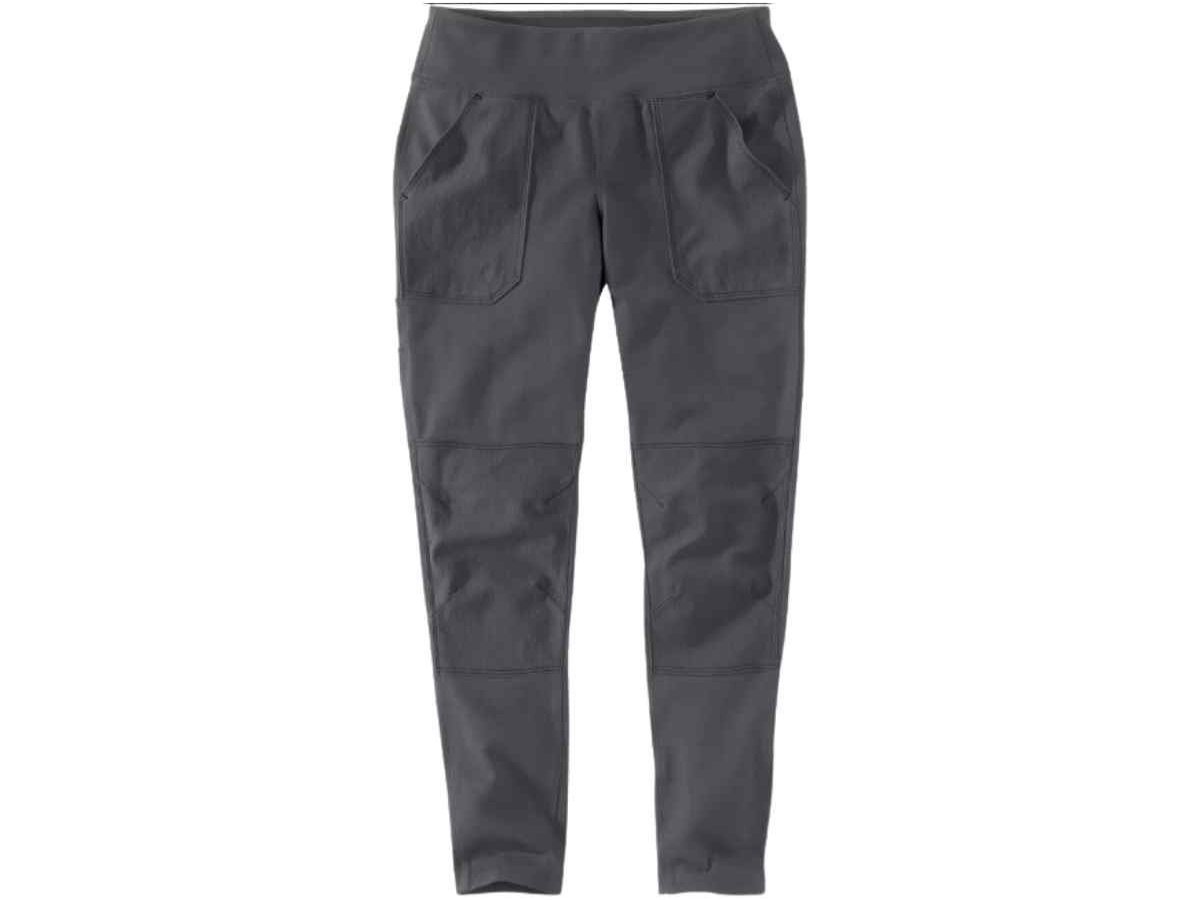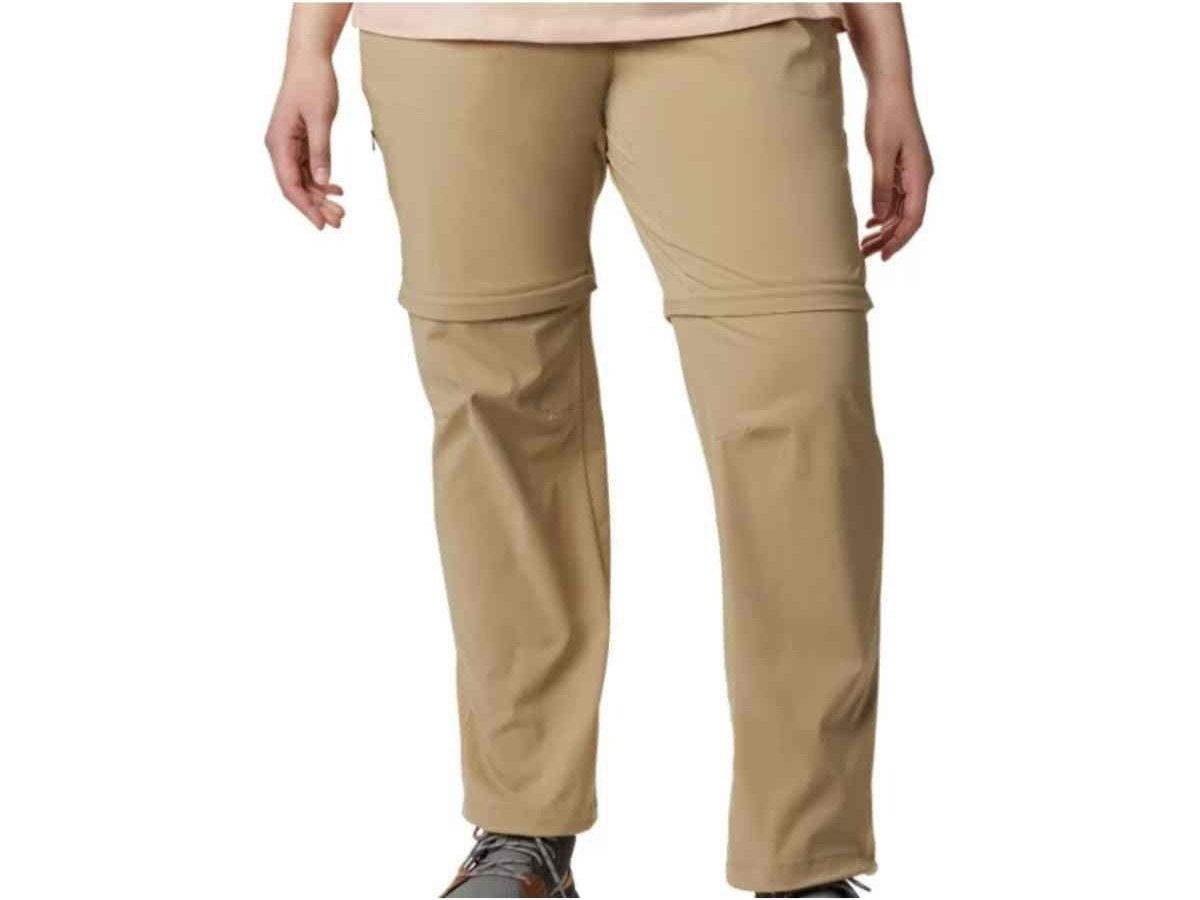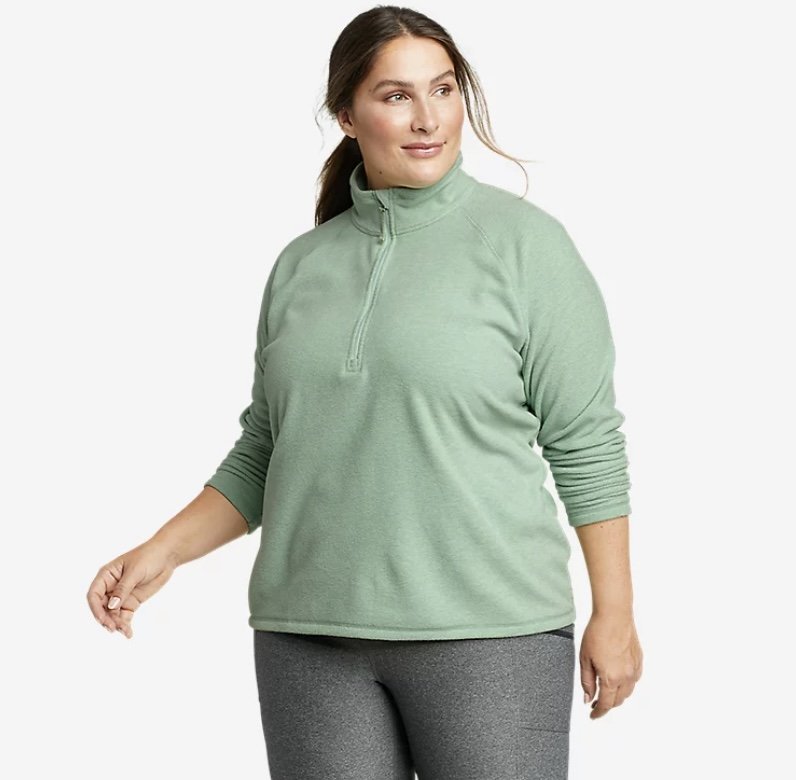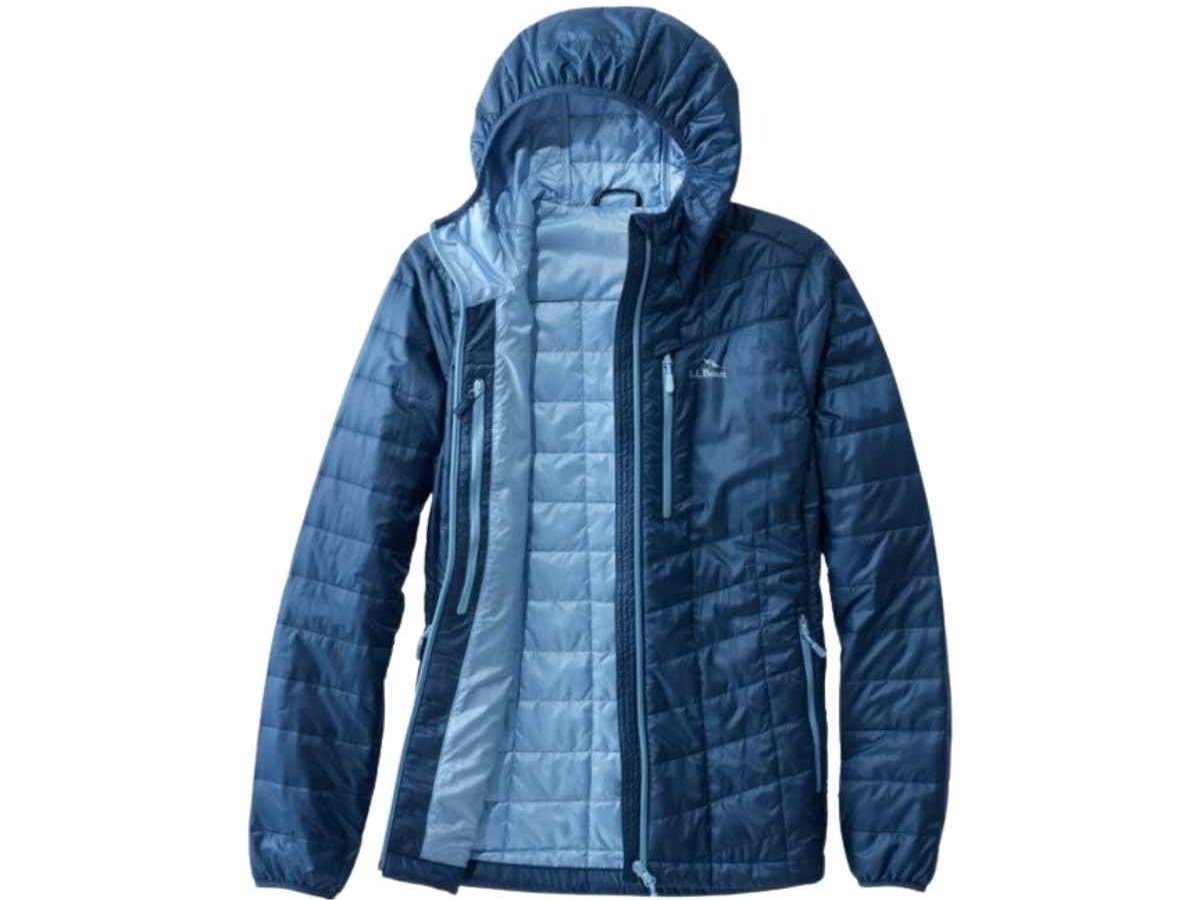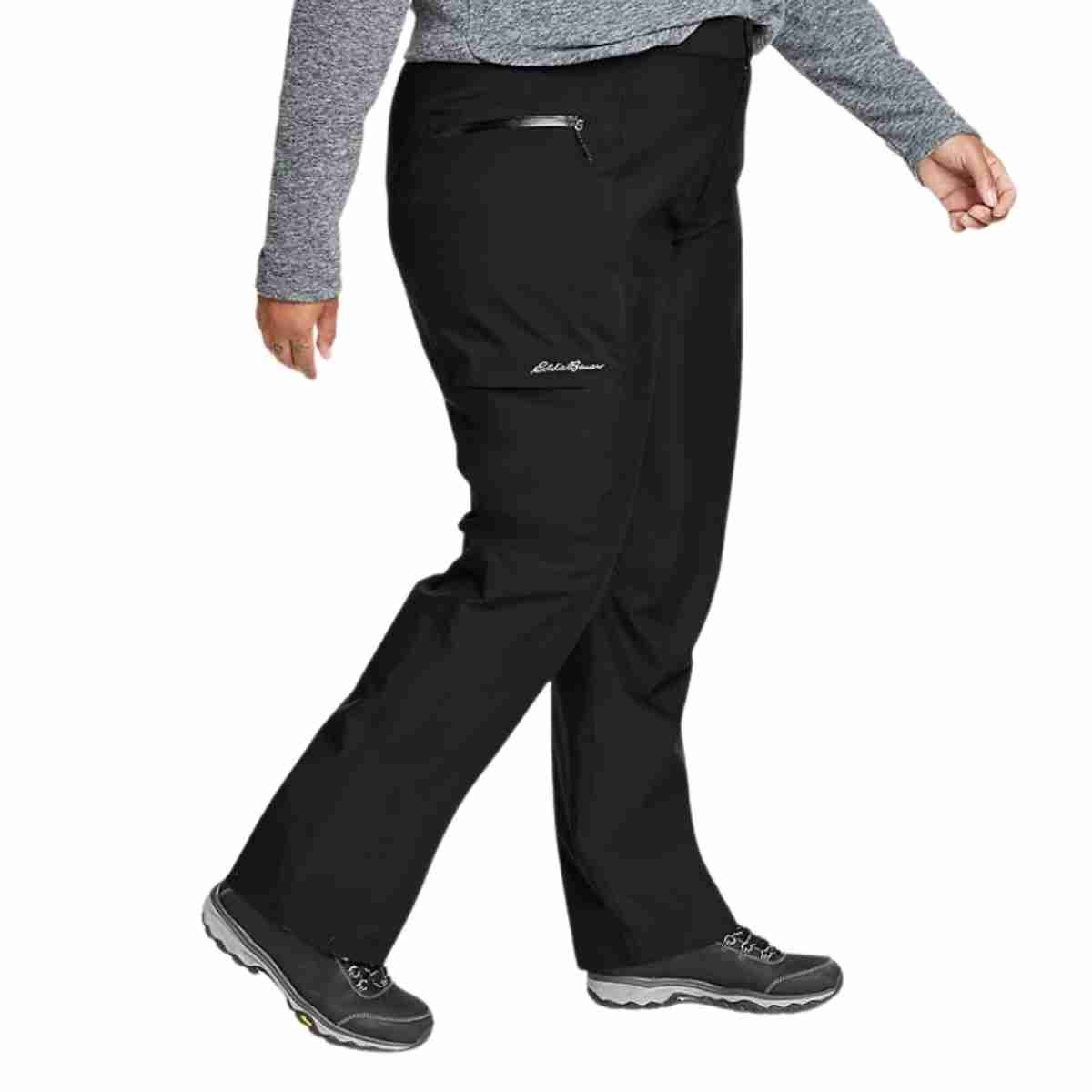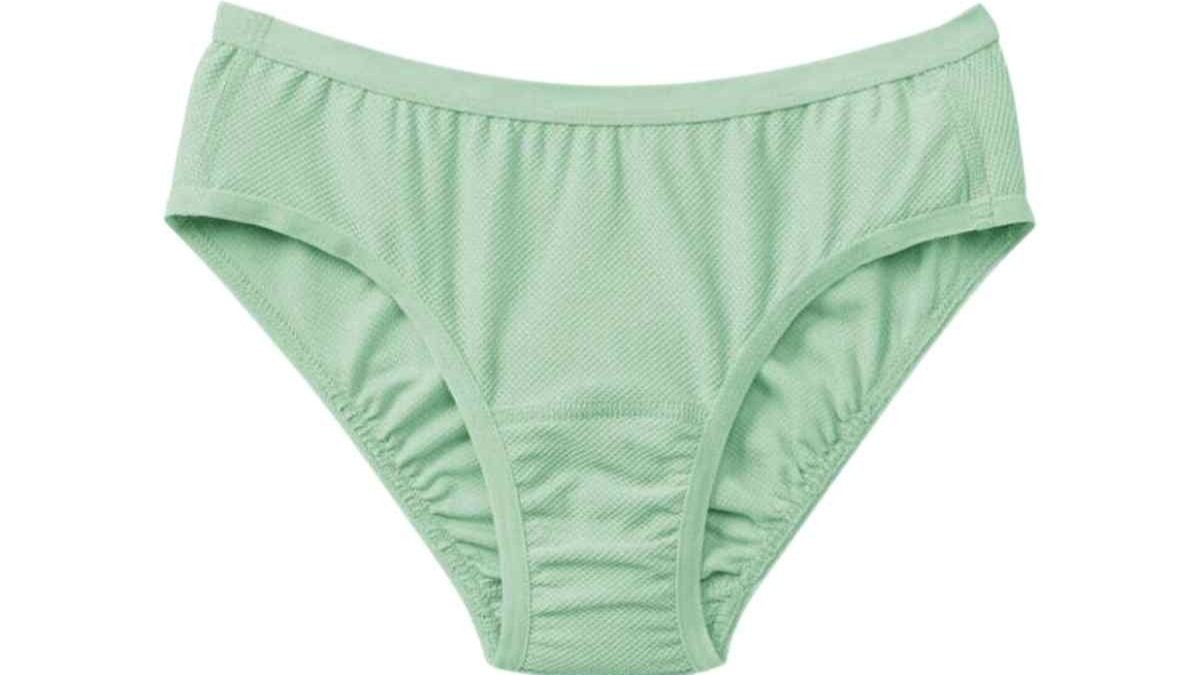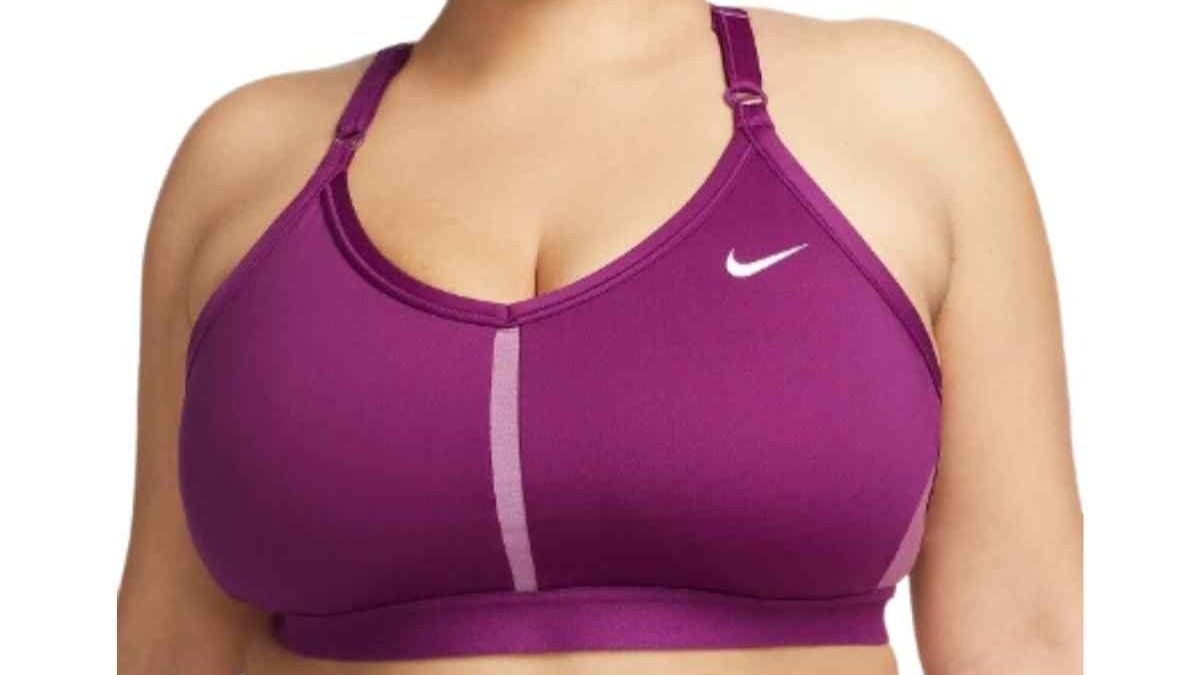Best Plus Size Outdoor Clothing of 2025
The Best Camping And Hiking Clothing For Plus Size Bodies
May 19th, 2025, updated to reflect many new models of clothing we tested including rain jackets, insulated jackets, and bottoms
Home > Gear Reviews > Apparel
It is difficult to find plus size outdoor clothing made for camping and hiking. There's a gap between the needs that plus size hikers are openly asking the outdoor industry to address and what the outdoor industry is currently offering. That said, some brands are catching up and delivering outdoor clothing that fits, supports, and celebrates plus-sized bodies.
All intersections of people and experiences deserve access to nature, and they deserve outdoor gear — including clothing — that will allow them to do so safely and comfortably.
Here are my recommendations for the best plus-size outdoor clothing — from the best plus size hiking pants to waterproof jackets, underwear and sports bras, footwear, trail pants, tops, softshell and fleece jackets, and more! Because we all deserve to get outside and feel comfortable while doing so.
While this guide focuses on the best plus-size outdoor clothing, those who are big and tall also face unique challenges in finding gear that fits. For individuals seeking big and tall options, a comprehensive guide on the Best Big and Tall Outdoor Apparel offers helpful recommendations.
Related: Best Plus Size Sleeping Pads and Sleeping Bags, Best Plus Size Winter Outdoor Clothing.
We create reader-supported, objective gear reviews independently selected by our editors. This story may contain affiliate links, which help fund our website. When you click on the links to purchase gear, we may get a commission, without costing you an extra cent. Thank you for supporting our work and mission of outdoor coverage for every body! Learn more.
About My Journey
My body is a fat body, and it is Brown. I own these two identities, and my existence in them is a journey longer than any trail I'll ever hike. I shouldn't have to deal with any special hardship when outdoor clothing my body for camping and backpacking—my primary ways of engaging with the outdoors.
But over the years I've bought and returned countless hiking clothes, plus-size activewear, and outdoor gear that wasn’t designed for my body. I've also scoured internet forums for posts from other plus-size hikers to learn which outdoor brand may have outdoor gear designed for us and to find gear options that work.
I've learned a lot in my research and experiences with plus-size hiking clothes and outdoor gear, and it's important to spread that knowledge so that others don't have to struggle.
For all the talk of body positivity and all the inspirational images on Instagram, the outdoor industry has not yet caught up to the needs of plus-size hiker folks who want technical outdoor clothing but are not yet able to consistently find it.
There is still a huge gap when it comes to hiking clothing and outdoor gear items: what's made for people whose bodies conform to social norms is often more functional and more stylish than what's made for people whose bodies are "different" in some way.
Whether you are a beginner looking to take up camping and hiking, or an experienced adventurer looking for some new outdoor gear that will work better in a variety of outdoor activities, these are my recommendations for building your outdoor gear closet.
In this guide, I focus on gear for plus-size adventurers, with recommendations on what's best in regard to sizing, support, fabric, and suitability for hiking, camping, and backpacking.
You can also check out my interview with Jenny Bruso, founder of Unlikely Hikers and advocate for representation of all bodies in the outdoors.
Plus Size Outdoor Clothing List
| CATEGORY | MODEL | SIZES | PRICE |
|---|---|---|---|
| BOTTOMS Read more |
|||
| Outdoor Research Ferrosi | 1X - 3X | $98 | |
| Athleta High Rise Elation Shorts | 1X - 3X | $98 | |
| REI Co-op Pursuit Skort | 1X - 3X | $60 | |
| L.L.Bean Water-Repellent Comfort Trail Pants | 16 - 20, 18W - 26W | $70 |
* Price reflects MSRP. We note any discounts we see on our Deals page, which is updated daily.
Bottoms
Outdoor Research Ferrosi Pants
Sizes: 16-24 (I’m wearing a size 20), available in short and tall
The Outdoor Research Ferrosi Pants are probably the first trail pants I have tested that I actually like, namely for their breathability, comfortable waistband, and adjustable cinches at the ankles and the waist. As a hiker, I have never been a fan of hiking pants. I’ve always preferred leggings or shorts, finding most hiking pants to either not come in my size at all or fitting awkwardly at my waist while too large on my legs. The rise of most hiking pants also feel too low for me, as I prefer to feel more support from a higher pant rise.
Compare Prices Of The Outdoor Research Ferrosi Pants
The author hiking in the snow with her dog in the Outdoor Research Ferrosi pants.
The waistline feels like a midrise, which comfortably sat at my belly button during the first hike I took it on: a 4 mile hike in light snow. I fell a few times, and crossed two creeks and climbed over several logs. The Nylon and Spandex ripstop fabric is made up of 46% recycled fabric, and it felt durable through this whole hike. While I am not a climber, I do feel like they will hold up while scrabbling up rocks, and I plan to use them in the summer when I hike through more areas where the pants are likely to scrape against granite frequently.
The Outdoor Research Ferrosi plus size pants have plenty of stretch for playing around outside.
The cinches at the ankle were intuitive and nicely fit in my boot, allowing me to keep my ankles dry in the 30 degree temperatures I was in. These are not winter pants, and I would not use them for deep snow hikes. That being said, I layered the Outdoor Research Alpine Onset Merino Bottoms with the Ferrosi Pants and stayed dry and warm. If I had sat in the snow for more than a few minutes, I would have gotten wet, but they feel fairly water resistant. I look forward to taking them on lightly raining hikes.
I found the pockets to be deep enough to comfortably hold my phone, chapstick, and the gloves I shoved in. I did find myself wishing there were cargo style pockets lower on the leg.
Mostly, I love these pants because I can see myself wearing them almost all year (I’m a Northern Californian though, so take that with a grain of salt!) and in many different spaces.
They are attractive enough to be paired with a pair of chacos for a trip to the brewery and durable and comfortable enough for me to replace my usual leggings on my future hiking trips. If you are looking for a pair of hiking pants to get you started, the Ferrosi are a good option that fit true to size. I look forward to seeing how Outdoor Research further develops its plus and extended size collection, and I hope to see even more size options (hello, size 26 and 28!) to come.
Sizes: 1X-3X
I love the activewear company Athleta, and their High Rise Elation Shorts are no exception. My favorite Mesh Me Up shorts were discontinued, but the Elation has a similar length, is one of Athleta’s most popular models, and is available up to 3X.
View the Athleta High Rise Elation Short
I first found the brand several years ago, when I was looking for workout leggings and shorts that were cute and durable. Unlike my friends, I couldn’t splurge on a pair of Lululemons (which sells up to size 20 in their most popular items). I could make Athleta’s prices work, though, so splurge I did.
For many folks with big thighs, rubbing doesn’t just happen on the upper thigh, so shorts with shorter inseams can still cause painful chafing. I've found an 8” inseam is a great length for hiking. The Elation shorts are 7", which is almost as good as the old Mesh Me Up shorts.
I also love how soft they feel, even though they’re thick enough not to rip easily when scrambling over rocks and logs. The fabric is rated UPF 50+, which I’ve found to be rare in plus-size hiking shorts and even rarer with activewear. Great ventilation means that after a long day, I don’t feel sweaty or constricted, which sometimes happens with spandex bottoms. These shorts also don’t roll up at the leg or down at the waist, and bending and sitting don’t feel constricting.
Athleta’s size range tops out at 3X, and these shorts—like the rest of their line—are pricey. You can also periodically check our Deals page or Athleta’s sale section and score finds from there.
Sizes: 1X-3X
If you are wondering if I’m recommending a skirt (or a skort, rather) for hiking and camping, you’re absolutely right. Hiking skirts and dresses have become popular, especially for backpackers who want ventilation and ease of movement as they bend, climb, and scramble. Skirts also make going to the bathroom much easier.
View The Rei Co-op Active Pursuits Skort
For me, however, I never found a hiking skirt I truly enjoyed that wasn’t a skort—a skirt with shorts built-in. My thighs are too big to hike for any amount of time without some sort of fabric in between to prevent them from chafing. In my daily life, I generally wear a pair of shorts under dresses, so I wouldn’t recommend a true skirt to anyone who deals with chafing.
I recommend starting with the REI Active Pursuits Skort, which is the updated version of an old but now discontinued favorite, the REI Beyonder Skirt. Its look is not quite as flowy, but the pockets are much bigger now to fit a phone and now there are three pockets. It has an elastic waistband instead of a drawstring.
What makes this style skort great is how breezy it feels, even with the built-in shorts. The shorts don’t sit too close to my body but still prevent that much-dreaded chafing. I wouldn’t use these beyond a casual camp and day hike situation, however, as I didn’t find the material to be very thick and would prefer other bottoms for overnight backpacking trips.
Like other extended-size offerings from REI, it only goes up to a 3X, proving that there is still room to grow when it comes to size inclusivity. They’re generally price accessible and REI Co-op brand clothing goes on sale frequently, so check the Deals page, especially around holidays.
Sizes: 16-20, 18W-26W
If you plan on doing more serious hiking and putting in more miles, I recommend investing in a solid pair of trail pants. That being said, trail pants can be hard to come by for folks above a size 14. I’ve found, generally, that most trail pants lack stretch, and bending and squatting can be difficult.
While the Columbia Saturday Trail II (reviewed below) are my recommendation for beginning hiking pants and are the best plus size hiking pants for your first pair, I prefer the L.L.Bean Comfort Trail Pants for a few reasons.
View The L.L.Bean Comfort Trail Pants
I don’t have a flat stomach, and tight trail pants often fit me like tight jeans—squishing my stomach above my waistline or pinching uncomfortably. I find the L.L. Bean Comfort Trail Pants to be stretchier and lighter than others I’ve tried, but still sturdy. I’ve worn them on an especially thorny and brambly hike—the kind of trail that would rip a pair of leggings or lesser pants—but these withstood it all. I really like the zipper side pockets that hold my chapstick and my extra hair tie when I’m out hiking, and I find the cinching especially helpful if I’m sliding on a pair of gaiters or want a modicum of protection against ticks.
L.L. Bean is an outdoor brand that I’ve long supported. They’ve been offering plus size clothing — up to a size 26 — for a long time, and I find their offerings to all be sturdy and well-made. All of my L.L. Bean gear has lasted for years, so you can feel confident that your initial investment won’t go to waste.
Sizes: 1X-3X
Hiking in leggings can be tricky since activewear isn't designed to be as tough as trail pants, can hold smell and bacteria more easily, and doesn’t dry as quickly. I’ve found the Athleta plus-size leggings to be a great exception to that rule.
View The Athleta Elation 7/8 Legging
Leggings by Athleta and puffer from Athleta. Backpack by The North Face. Photo courtesy of Gabi Reyes-Acosta
Athleta makes lots of their tights in this ⅞ length, which I love since I often find their full-length leggings are too long for me. They’re long enough that I can pull my hiking socks over them, so evenings spent at camp are comfortable when I’m wearing these with my Chacos.
The Athleta Contender Mesh are nearly perfect if you plan to do day hikes from your campsite. The mesh behind the knees provides airflow as you gain elevation and sweat, and they’re comfortable enough to be worn all day.
Still, leggings, in general, provide less protection against bugs, scratchy trees, and rocks, and since these leggings are mesh-heavy, they won’t be especially warm at night. You’ll need to have another pair of bottoms (like pants) available to stay comfortable in all conditions.
The Athleta Contender Mesh ⅞ Tight is an investment, but I wear my Athleta leggings so much that I’ve long ago stopped feeling the hit to my wallet. Athleta’s sizing, however, only runs up to a 3X, so keep that in mind when shopping.
Sizes: 1X - 4X
A good pair of tights is invaluable. It’s currently still late winter in Southern Idaho where I live, so I’m not frequently wearing pants outside that are non-insulated. Lately though, the sun has been shining, and I’ve been able to test the Mari Tights around my homestead, while practicing yoga at home, and while on short hikes.
The Mari Tights are simple but effective. They lack pockets, which is my only knock against them, but are otherwise lightweight and comfortable.
I took them out on a run on a warm day, and they stayed firmly on my waist. I’ve worn many leggings over the years that roll down with quick movement, but the Maris stay secure on my body without sagging even after a long day of wear.
You can see my article on Cotopaxi's Extended Sizing collection.
View the Cotopaxi Mari Tight
The Mari tights are comfortable for every day and on trail use.
I would recommend using the Mari for everyday wear, yoga, running, and short hikes. The lack of pockets, breathable venting, and the thin fabric that feels like it would easily snag or rip on rocks and branches make the Mari Tights better suited for off-trail everyday use rather than on.
Sizes: 1X-3X
Carhartt is a brand built with durability in mind, so when I started looking around for plus-sized hiking gear, I knew it was a solid place to start. The Carhartt Force Utility Knit Leggings are particularly great for hiking because they’re abrasion-resistant, so they’re a bit thicker than your average leggings, and have reinforced knee panels.
View The Carhartt Force Utility Knit Legging
The fabric also wicks sweat and resists smells. I particularly like the wide waistband, which doesn’t roll down as you move around, making them feel comfortable and secure.
The Force Utility Knit leggings are still an investment, but Carhartt offers a payment plan called Afterpay, making them more accessible. As for sizing, they only go up to a 3X, but they seem to be generally true to size.
Sizes: 16W - 24 W
I’m also a sucker for convertible pants. I don’t backpack in winter or snowy conditions generally, so a hiking pant that is light and intentionally versatile, such as the Columbia Saturday Trail II Convertible Pants, is nearly perfect. For someone just building out their hiking closet, I’d highly recommend you start with these pants.
View The Columbia Saturday Trail Ii Convertible Pants
The fabric is rated for UPF 50 sun protection, and the shorts land right above the knee, giving you that longer inseam that protects against “chub rub.” Note that the waistband isn’t wide, which more structured pants (vs. leggings) tend to need so that bending and sitting isn’t uncomfortable for people with bellies.
I do tend to find that Columbia runs small, so I have always sized up my Columbia purchases. Reading the size chart is a must for any plus-size purchasing you do, and I further advise you to check reviews to see what others say about the fit.
I will say, though, that Columbia as an outdoor brand is more size-inclusive than most outdoor clothing companies, with sizes going up to 24. These pants are on the pricey end, but given that they’re such a foundational piece in your outdoor closet, they’re a good investment.
Tops And Shirts
Outdoor Research Feedback Flannel Shirt
Price: $95.00
Sizes: 1X-4X (I’m wearing a 3X but could likely size down)
A good flannel is worth its weight in gold. That isn’t a saying of any sort, but it’s proven true for me. A flannel is my go to for hanging around the campfire, going on windy beachside hikes, and everything in between. I am tall, with broad shoulders and long arms, and find many flannel shirts to be either too short or too tight, especially across my chest. When hiking and adventuring, I prefer a looser fit, and I have hard time finding that in combination with technical aspects like breathability, UPF protection, and sweat wicking capabilities. With the Feedback Flannel, I have found these features and am excited to wear this shirt for years to come.
VIEW THE FEEDBACK FLANNEL SHIRT
The author hiking in the Outdoor Research Feedback Flannel shirt.
The 100% Polyester fabric is bluesign approved and feels more like cotton than Poly. It also sports UPF 50+ protection for sunny hikes. The shirt feels thick, and it kept me warm during a rainy hike in late October. The pockets on each side were a pleasant surprise, especially because they were large enough for my phone and my hands. The length of the shirt was perfect for me, sitting below my waist and it was comfortably long for my 5’9 frame.
The drop tail hem wasn’t too pronounced, which I appreciated because I often find the longer back end to hang too low and look awkwardly large. The only length issue for me came in the arms, which were not long enough to cover my wrists. If you are shorter this will likely not be an issue for you though. I would say that this shirt overall is slightly oversized, but I prefer that as I can imagine myself layering base layers, like the Outdoor Research Alpine Onset Merino 150 half-zip underneath during cold temperatures.
The flannel itself is soft but thick, and it held up as I scraped it through a trail of shrubs and wet tree branches. I felt myself sweating as we gained elevation but the shirt kept me dry, especially on my lower back which is usually a problem area for me when it comes to sweating during hikes.
This flannel will be in frequent, and most likely constant, rotation in my closet. While I would not wear this shirt during the height of summer hikes, I can see myself throwing it on during cool summer evenings and throughout the winter and fall. When I ski this season I plan to pair it with a merino baselayer under my OR Carbide Bibs, and I’m sure I’ll be comfortable and warm under my jacket during the sunny, 40 degree days. The Feedback Flannel is my favorite technical flannel I’ve worn, and I know I’ll be investing in more of them.
See our guide on Plus Size Ski and Snow Pants and Bibs for more recommendations.
Sizes: 1X-4X
The Smartwool Classic Thermal Merino Base Layer Crew is a long-sleeve, next-to-skin layer that’s made of a heavier-knit Merino wool.
As a note, it does fit close to the body, which may or may not be what you’re looking for. It’s great for both shoulder season hiking and layering in colder weather.
View the Smartwool Classic Thermal Merino Crew
Wearing a North Face Denali jacket in Zion National Park in December, with the Smartwool Classic Thermal Merino Base Layer Crew underneath. Photo Courtesy of Gabi Reyes-Acosta
During a trip through northern Arizona and southern Utah in early December, this shirt was vital to my comfort as we camped and hiked in snowy conditions. At $100, this shirt is an investment when it’s full price—and I don’t often see it cheaper than that.
Since I originally wrote this article, Smartwool has done much more in terms of overall plus-size offerings. When I first wrote this story, they only had two plus size options. Now, they have ten options. In the past, you couldn’t sort offerings by size (they go up to 4X now).
Now Smartwool has a dedicated Plus Size landing page so you can search for other items in their catalog.
Sizes: 1X - 4X
I was excited to try Cotopaxi’s Teca Fleece, with sizes ranging from XS-4X, because I had long wanted to rock Cotopaxi’s distinctive colorful jackets. As much as technical gear is necessary and important to me, so is gear that looks great and makes me feel great. The Teca Fleece, while not the most technical fleece I have owned, is warm enough for most uses and is cute to boot.
The Teca also lacks adjustable hip or waist cinches, but it does sport an attractive elastic around the bottom of the jacket and at the sleeves that kept the jacket secure against me.
When layered correctly though, the Teca is practical and useful on shorter hikes, walks around town, and everyday use. When paired under the Fuego Down Jacket with wool base layers underneath, I felt comfortable and warm as the snow fell on a short snowshoe hike.
My favorite thing about the jacket is the fit. Like the entire line from Cotopaxi, the jacket goes up to a 4X. With many outdoor brands, I’ve found that sizes run 1-2 sizes too small. With all the items I tested from Cotopaxi, I found their sizes to run true and even slightly roomy. I tested the Teca fleece in a 3X, and found it to be fairly long in the torso and roomy.
View the Cotopaxi Teca Fleece



Sizes: XL - 4X
This baselayer shirt is made of 88% Polyester and 12% Spandex. It is claimed to be heavy enough to retain warmth in temps as low as 0°F. I wore this base layer under a wool shirt from Patagonia in low 20° temperatures for an entire day of cross-country skiing, and it felt breathable as we moved and held in the heat during our rest periods. Even after three days of wear, this base layer never stank, despite the fact that I sweat moderately. This baselayer shirt goes up to a 4X, which is rare among the available extended or plus size clothing on the market right now.
View the DSG Outerwear D-Tech Base Layer
The author is wearing the North face Denali jacket and Columbia leggings. Photo courtesy of Gai Reyes-Acosta
Jackets & Fleece
Outdoor Research Trail Mix Cowl Pullover
The OR Trail Mix Cowl Pullover is a warm and versatile fleece that performs well in a variety of settings and conditions. We tested the pullover over in the late fall and into winter, and even after many washes we found no pilling.
The microgrid fleece is soft to the touch and has remained so after TK months' use. The cowl neck pullover is great for cold days in town but was even better on cold and snowy hikes, with a tight weave that kept out the biting wind during the days on the trail, on a ski day, and a snowshoeing trip.
View the Outdoor Research Trail Mix Cowl Pullover



The Trail Mix is warm, and keeps one warm throughout the day without overheating or sweating. The material feels breathable, soft, and the UPF 30 makes it perfectly suited for bright cold days.
The fit is comfortable: not too snug, not too large, but long enough to hit just below the hip and true to size. It can be worn as a midlayer, but OR recommends wearing it next to skin for the Thermo-Regulating ActiveTemp Treatment to work best. When testing, we tried it both ways (with a base layer underneath and without a base layer) and found the temperature regulation to work equally as well under both layering conditions.
The OR Trail Mix Cowl Pullover is a great piece for cold weather temperatures and activities without a ton of bulk or weight, making it a great size-inclusive option.
Price: $60
Sizes: XXL, 2X, 3X
I’m a sucker for a ¼ zip fleece, and the Eddie Bauer Quest Fleece ¼ Zip is a solid choice.
In general, it’s difficult to find technical fleece for plus size bodies, but the Eddie Bauer Quest Fleece 1/4 zip gets pretty close. It’s lightweight but warm enough to feel comfortable during cooler evenings (I run hot, so plan accordingly). The ¼ zip is great for adding ventilation, which helps sweat evaporate.
View The Eddie Bauer Quest Fleece ¼ Zip
I am tall and have broad shoulders, but the sleeves are a good length, though I do wish it had thumb holes. Sizing goes up to a 3X.
Cotopaxi Teca Half-Zip Windbreaker
Sizes: 1X - 4X
For the longest time I wasn’t sure what the purpose of a windbreaker even was. This mostly stemmed from never having worn them, as most of the first decade or so of adventuring outdoors was during a time where windbreakers weren’t being made and sold for plus sized and fat folks. The Teca Half-Zip has made me into a windbreaker believer, and I wonder how I’ve gone without one for all these years.
The Teca Half-Zip, like all of Cotopaxi’s line, comes in color options that let you stand out on the trail and in town. I tested the Teca in the “Super-Food” colorway and received tons of compliments.
Beyond the aesthetics, the Teca is exceptionally light and paper thin without feeling cheap. Instead, it is easy to forget that it’s even being worn. It gets very windy where I live, and I tested the Teca during several instances where the winds were at almost 30 mph. During these tests, the Teca Half-Zip kept me from feeling the wind chill while hiking. To be clear, the Teca Windbreaker is not made to repel water nor to keep one warm. When layers are added underneath, I found it to enhance the warmth due to its ability to block out the wind. In the late spring, summer, and early fall I can imagine turning to this jacket anytime I need a light layer and wind protection.
View the Cotopaxi Teca Half-Zip Windbreaker



The Teca comes with two large zippers: a kangaroo pocket at the front and a zip pocket that enables the jacket to be folded into itself. Made from 100% repurposed polyester taffeta with DWR finish and repurposed polyester ripstop, the Teca feels sturdy against harsh winds and sharp branches.
I found the fit to be a bit closer to the body than the other items I’ve tested from Cotopaxi, so if you plan to layer heavy items underneath I’d recommend sizing up. I tested a 3X and was able to layer beneath it with my Outdoor Research Trail Mix Pullover, but I would not be able to layer with anything bulky.
A windbreaker is an important part of an outdoor gear closet, and the Teca Half-Zip is a size inclusive option that provides wind protection and helps me go further, for longer.
I adore the REI Co-Op 650 Down Vest. I’ve always struggled to find comfortable vest armholes since I have large arms and broad shoulders, so it took me a long time to come around to vests—but this vest is such a good piece of gear. It keeps your warmth in your core, keeping you snug but free to move around. REI also considered sustainability when making this vest—it’s made out of recycled nylon, so you can feel good about it without scrimping on quality or warmth. While it’s usually an $80 down vest, it often goes on sale.
The REI Co-op 650 Down Vest is a winner in our Best Women's Down Vests guide.
View The REI Co-Op 650 Down Vest
I pair this with the Smartwool Classic Thermal Merino Crew and it’s a great combination for staying warm for hiking in chilly conditions—though you’ll need more layers if you’re going out in the snow.
Sizes: 1X - 3 X
I once went to The North Face Outlet in a desperate attempt to find a hiking rain jacket in my size. I didn’t find a rain jacket, but I did find my now-favorite mid-layer, The North Face Denali fleece jacket. It runs small—I wear a 3X when I’m not usually a 3X in outerwear—but it is the warmest and most comfortable mid-layer I own.
View The North Face Women’S Denali Jacket
North face Denali fleece, Athleta insulated leggings. Photo Courtesy of Gabi Reyes-Acosta
It’s definitely more suited as a mid-layer for shorter hikes or lounging around camp, however, since what you gain in warmth you lose in breathability. That being said, it’s heavy, bulky, and doesn’t pack down small, so if you plan to backpack, be mindful of how much weight and space it will add to your pack. Still, I love mine so much that I bring it along every trip. It is an investment. But if you find it on sale—or tucked on a rack at a North Face outlet—I recommend snagging it.
Sizes: 1X-3X
I have always wanted a Patagonia Nano Puff Jacket but never could fit into their sizing. The L.L. Bean PrimaLoft Packaway is almost identical and is available in sizing up to 3X for women’s apparel.
In contrast, Patagonia’s sizing for the women’s Nano Puff includes women’s XXL and the men’s Nano Puff has sizing up to 3XL.
View The L.L.Bean Primaloft Packaway Hooded Jacket
The author is wearing the Athleta down jacket and LL Bean fleece underneath. Photo Courtesy of Gabi Reyes-Acosta
For the longest time, I wore an old Athleta performance puffer that no longer exists. While I want Athleta to bring back more plus-size outerwear options, I’m so glad that this PrimaLoft Packaway Hooded Jacket from L.L.Bean exists. It’s extremely light but keeps you warm on cold days and nights. It’s also compressible, making it an excellent backpacking companion. It goes up to a 3X and is worth every penny— but I’ve often seen it on sale for $20 to $40 less. The Packaway is also a winner in our Best Synthetic Insulated Jacket guide and was the only jacket we considered that uses recycled synthetic material for the face fabric.
Sizes: 1X - 4X
Stylish, trendy, and practical to boot, the Cotopaxi Fuego is an all around down jacket that will carry you comfortably through three seasons and even into many winter conditions.
I’ve tested the Cotopaxi Fuego down jacket for the past year, including throughout winter months in Idaho and Utah.
I took it with me on hiking and snowshoeing adventures and as a daily usage jacket on my small homestead. The Fuego kept me comfortable as I fed livestock, baled hay, and spent time in cold and snowy conditions.
While it isn’t the warmest or most technical down jacket on the market, it is still a solid contender for most front and backcountry uses and will keep one warm throughout the majority of the year. With colorful designs, sustainable and ethical practices in creating the garments, and increased size inclusivity, the Fuego is a down jacket that I will turn to again and again.
You can read my in-depth review of the Cotopaxi Fuego jacket here. It's also featured in our Best Down Jackets guide.
View the Cotopaxi Fuego Jacket
Sizes: 1X - 4X
The Capa Insulated Jacket from Cotopaxi is one of my favorite synthetic jackets I’ve tested, and is an excellent three season option that is lightweight and comes with the signature bright and standout Cotopaxi color options.
When choosing a synthetic fill versus a down fill jacket comes down, for me at least, to intended use and the climate in which it will be used. The Capa is firmly a three season jacket, lightweight and breathable while providing warmth that is best suited for summer nights and fall mornings. I tested the Capa in early Spring in Southern Idaho, where temperatures generally remained in the 30’s and 40’s. Without a fleece layer underneath, I felt chilled when temps went below approximately 45 degrees. That doesn’t discount the Capa for me though, as I felt comfortable and warm during a hike at City of Rocks National Preserve with my Outdoor Research Trail mix Pullover layered beneath the Capa. The Capa’s packability and lightness made it perfect for shedding and packing away as I hiked.
Capa Insulated Jacket



The Capa, much like Fuego Down Jacket, is lacking in adjustable features that I would like to see in a jacket. The wrist and waist hems are elastic, and while they stick close to the body wind can be felt going up the arms on a hike. The Capa also comes in a hooded version, which I did not test. Like the Fuego though, the hooded version of the Capa lacks any cinches or clips to customize the fit of the hood.
Despite the lack of adjustable features the Capa excels in packability, weight, and synthetic insulation that kept me warm even in light rains. Unlike a down fill jacket, the 100% recycled materials synthetic fill in the Capa stands up to light rains without getting me wet or feeling heavy and weighed down by the weight of water soaking into the down. The Capa’s shell and lining is made from 100% recycled 20D ripstop nylon with PFC-free DWR finish, with recycled synthetic PrimaLoft Gold P.U.R.E. (Produced Using Recycled Emissions) insulation. This is in alignment with Cotopaxi’s sustainability goals and mission.
The fit, like the other Cotopaxi items I’ve tested, is true to size and even slightly roomy. Overall, the Capa is going to be my go to jacket in mild and chilly temperatures and it will be equally useful while camping, backpacking, and in town use.
Waterproof Layers
REI CO-OP Rainier Rain Jacket
Sizes: 1X-3X
Rain jackets are one of the toughest items for me to find off the rack in store, and even with online shopping I have traditionally struggled to find a jacket that is breathable, waterproof, and that doesn’t run too small so I can’t layer comfortably. Because of this dilemma, I often don’t hike in the rain or do so with the understanding that I may get wet. This isn’t a perfect solution, nor have I done it very recently upon purchasing the REI Rainier Jacket. With this jacket I can go further and last longer outside.
View the REI Rainier Rain Jacket
We love the hood on the Rainier, how water rolls off it.
I wear a 3X in the Rainier and find it to be true to size, with some extra room in the shoulders and arms. I like to layer a fleece underneath and don’t feel too constricted across my arms or chest, which are often problem areas when it comes to fit for me. The Rainier also sports the adjustable features I look for in a jacket. The Velcro cuffs haven’t worn out after multiple uses that include getting mud in them. The cinch at the front of the hood and the clip at the back ensure a snug fit around my face without the hood getting in the way of my glasses.
With the adjustable features and comfortable fit for sizes up to 3X, I find the Rainier to be a versatile and capable rain jacket. Another jacket I’ve tested that performs well in the rain is the Outdoor Research Helium Rain Jacket. Check the size chart and try on first if possible, as I did find that the jacket ran one size too small.
The REI Rainier rain jacket is also a winner in our Best Lightweight Rain Jackets guide and our Best Kids’ Rain Gear guide and we appreciate how REI has made this jacket available in a wide variety of sizing from kids to adults so everyone in the family can benefit from its quality and value.
Sizes: 1X-3X
Finding technical rain gear for plus-size adventurers is hard—remember my search for a rain jacket at The North Face outlet?—but the Eddie Bauer Packable Rainfoil Jacket and Cloud Cap Stretch Rain pants have worked well for me.
It's waterproof, breathable, and slim-fitting, but built to be worn on top of base or mid-layers. They’re pricey—each around $120—so I would watch for a sale or buy them over time if the price is a factor, as it was for me. Both are well worth it, though—especially the jacket, since it can be worn in so many settings on and off the trail.
If you're really on a tight budget, Frogg Toggs makes affordable rain gear in 2X sizing and men's 3X sizing. It's not the most durable, but it’s lightweight.
View the Eddie Bauer packable Rainfoil Jacket
Sizes: 1X-3X
The Eddie Bauer Cloud Cap Stretch Rain pants have worked well for me.
Both of these pieces are waterproof, breathable, and slim-fitting, but built to be worn on top of base or mid-layers. They’re pricey—each around $130—so I would watch for a sale or buy them over time if the price is a factor, as it was for me. Both are well worth it, though—especially the jacket, since it can be worn in so many settings on and off the trail.
If you're looking for something more budget-friendly, Frogg Toggs makes rain gear in 2X sizing and men's 3X sizing. It's not the most durable, but it’s lightweight.
View the Eddie Bauer Cloud Cap Stretch Rain Pants
Footwear
For me, comfort starts and ends at my feet. If my feet are cold, wet, or hurting, every mile feels like a million. I recommend that a plus-size hiker choose a hiking boot or sturdy sandal available as a wide option. Here are the models that work for me.
Merrell Moab 3 Mid Waterproof Hiking Boots
Sizes: 5-13, wide available
While hiking shoes are also on offer as you search for footwear, I always recommend boots for heavier bodies—they’re built for better support over long distances. Purchasing the Merrell Moab 3 Mid Waterproof boots felt like I was taking a big step toward becoming the hiker I knew I could be. I love how versatile they are—not overly heavy while backpacking, but rock-solid for day hiking. They work with a variety of outdoor activities.
Compare Prices Of The Merrell Moab 3 Mid
Athleta leggings, Athleta down jacket, REI flannel, Merrell boots. Photo courtesy of Gabi Reyes-Acosta
Their above-the-ankle length is both supportive and aesthetically pleasing.
My favorite part about the build? They come in wide sizes, which is a rarity in hiking boots. The footbed has supported my high arches (and plantar fasciitis) under my size 20 body up every steep trail I’ve hiked. And while I don’t wear orthotics, the Moab 3’s looser fit and wide sizing would likely leave enough room if you needed them.
I first tested the waterproofing on the Moab 3s by hiking 12 miles at Point Reyes National Seashore, crossing creeks, and letting the ocean roll up my toes. My feet came out dry, and since then I’ve worn these boots to hike in low snow, stand beneath waterfalls, and trudge through the rain. I also have done many creek crossings and climbs in Big Basin Redwoods State Park with these boots, and despite their somewhat clunky appearance, they’ve always felt supportive and kept me comfortable.
Sizes: 5-12, wide available
As with hiking boots, I recommend that a plus-size hiker choose a sturdy hiking sandal available in a wide option. I live in these sandals. The Chaco Z/2 Classic are perfect for lounging around camp (preferably with socks), going on a light hike, or scrambling over rocks and gravel. They’re also perfect in water, making creek walking and lake swimming easier and more comfortable than going barefoot. Chacos also come in wide sizes, ideal for fat folks with wide feet who are also in need of hiking sandals. Personally, I’m obsessed.
View the Chacos Z/Classic
Some people use the Chacos Z/2 Classic to hike longer distances, but they lack the ankle support I need to hike anything longer than 3 miles, especially on steeper surfaces. Chacos are also not suitable for me to bring as a camp sandal while backpacking, as they feel like a heavier weight to add to my overall backpacking load than I would prefer to carry.
Overall, however, I have found these to be more solid and supportive—without weighing me down—than other outdoor sandals.
Chacos are winners in our The Best Hiking Sandals and our Best Camp Shoes for this reason: they're that comfortable.
Underwear & Bras
Comfort and breathability start at the layers that touch skin—especially if you have skin that rubs and chafes like mine.
Duluth Trading Company Dry On The Fly Performance briefs
Sizes: S-XL, 1X-3X
These are even better than the Duluth Trading Company Buck Naked (for folks looking for underwear that is sweat wicking, breathable, and fits well.
The Dry on the Fly briefs go up to a 3X (hopefully Duluth starts carrying higher sizes than just a 3!) and they fit true to size. They come in colors and prints that Duluth often updates and rotates out, making the line of underwear feel dynamic and plus size customers feel seen, as so often clothes for us are not made with cute prints and colors.
The Duluth Trading Company Dry on the Fly Performance briefs are winners in our Best Women's Underwear guide.
There are very few options for technical plus size underwear, especially above a 3X. The Duluth Dry on the Fly underwear fit generously, and could potentially fit someone who typically wears a 4X.
I used to swear by my pair of ExOfficio Give-N-Go for hiking and backpacking which goes up to a 3XL, but I did notice that they run small especially after weight gain, so they are a good option for those under a 3X. The fit of the Dry on the Fly pair, although generous, doesn’t feel baggy or saggy after a day of moving. I haven’t found them to bunch in uncomfortable spots, need to be pulled up, and the waistband is smooth and sits comfortably against my skin. I don’t tend to be someone who sweats a lot, but when I do the Duluth underwear keeps me dry. There’s not a wedge in sight with the Dry on the Fly, as it should be.
Sizes: 16-30
The Chaffree Women’s Briefs are made to keep your skin cool and dry. They reportedly contain “Anti Bacterial properties” to help keep infection at bay.
View The Chaffree Underwear
This is perfect for multi-day trips where you won’t be showering and want to limit what you pack. What makes these briefs so great for bigger bodies is that the leg openings come in standard and wide, and sizes go up to US 24-26. They are pricey for underwear, coming in at about $48 US for a 3 pack (though this price is common for athletic brand underwear these days). They also ship from the UK, so you might wait longer to receive them if you’re in the US.
Sizes: 1X-3X
The Women’s Buck Naked Performance Hipster Underwear feels like a dream. These are my go-to hiking underwear—they don’t chafe at the top seam or inner thighs, nor do they roll down under my leggings.
View The Duluth Trading Co. Buck Naked Hipster
They contain zero cotton, and the nylon and spandex fabric make them perfect for moving and sweating. During my most recent backpacking trip, a quick in and out in Mokelumne Wilderness, I wore these and was able to rinse and dry them in just a few hours; pulling them back on, I felt fresh and ready to go.
They come in a few different color and pattern options, which are rare in moisture-wicking underwear and even rarer for plus-size athletic underwear. They’re also a good price, ranging from $10 when on sale and up to $21 for some patterns. Unfortunately, these only go up to a 2XL and seem true to size—I’m generally a 2XL in clothes, and these fit me well
Nike Indy Sports Bra
Sizes: 1X-3X
There seems to be a myth of the curvy woman that having a larger overall clothing size translates to having a large chest. But small chested fat women exist! I love the Nike Indy Sports Bra because it’s light, super breathable, and meant for low-impact activity. The racerback in particular feels supportive but not constricting. It’s comfortable enough that I wear the Indy off the trail too, as I work from home and venture out locally. The Nike Indy is a winner in our Best Sports Bras for A to D cups. Our guide to the Best Sports Bras for D+ Cups is organized by band size and cup sizes and has options for plus size folks with larger chests.
View The Nike Indy Sports Bra
I have medium-sized breasts and often find sports bras designed for a plus size woman to be thick and constricting, better suited towards high-impact workouts for large chests.
The Indy comes in several colors—I adore the Light Thistle—and it's relatively affordable for a sports bra. Nike still has a ways to go with plus size clothing options, however, as the sizing doesn’t go past a 3X. I do like that this bra is made sustainably, with at least 50% of the polyester made from recycled plastic bottles which, according to Nike’s website, “reduces carbon emissions by approximately 30% compared to virgin polyester.”
The author outside celebrating the joy that nature can bring.
Takeaways
One takeaway I want you to have is that brands and retailers can do so much more. Dedicated plus-size retailers have lots of athletic wear options, many of which I use hiking and backpacking, but most of their products don’t have the technical details like specific weaves, weight, or ventilation I crave. Outdoor clothing companies, on the other hand, don’t have enough offerings in extended sizes, and the sizing they do have doesn’t go high enough.
It’s as if they think people with bodies above a 3X don’t want to go outside—but they shouldn’t have the right to make that decision for us by limiting our clothing options. That being said, some options exist, and with inclusivity and additional body positivity making their way to the forefront at outdoor companies, I’m hopeful that someday things will change.
“Someday, I’ll be able to walk into a brick and mortar store; finger through the many sizes, colors, and cuts; ask a knowledgeable associate which one I should choose based on my needs; and walk out the door clothing in hand.”
Until that day, I will still be outside. I will still be climbing hills on trail, leaning into the burn in my thighs and loving how the sun feels on my body. My body has carried me through streams, over gravel and sand, and along snowy trails, leading to vistas that took my breath away. My body has done so many things for me, and I hope that this list, along with your own fortitude and belief in what your body can and will do for you, helps you on your journey—however long it may be.
Related: Read testimony, industry intel, and tips from plus-size athletes in our “Snowsports for Bigger Bodies” story.
Tips for shopping for plus size outdoor clothing
Understanding your specific needs and activities
Sizing and fit tips
Finding the right size and fit can be challenging, especially with the variations in sizing across different brands. Here are some tips to help:
Measure yourself:
Every brand has a size chart, and after studying countless numbers of them I’ve noticed that there is almost no standardization among sizes. A 20 at REI fits differently than a 2X at Outdoor Research, for example.
Information about your body, namely your hip, waist, and chest measurements, is vital to ensuring that you’re choosing the size best suited for your body. For good measure, knowing your shoulder width and arm length is also helpful. I keep my measurements in a note on my phone and I turn to it often. Unfortunately, there is often trial and error involved, as I’ve found some brands who make a size that aligns with my measurements according to their size chart but will still fit too small when trying on.
Look for size-inclusive brands:
Size inclusivity means different things to different clothing and gear brands. Most, like REI, Columbia, Eddie Bauer, and the North Face, top out at a 3X or a 22, which is, in my opinion, on the lower end of what brands should offer for plus and extended sizes. Some of my favorite brands making above a 3X include SuperFitHero which goes up to a 7X, Outdoor Research which tops out at 4X, and Cotopaxi which makes great jackets and fleece up to 4X. You can see my article on Cotopaxi's Extended Sizing collection.Read reviews:
Reviews are my most useful tool when buying new clothes, especially when people are kind enough to post photos. Look for reviews from folks who have already field tested the clothes and can speak to their durability and performance. When you find something you love, leave a review for the next person!Consider layering:
Layers are essential to ensure comfort on the trail, as they can be added or shed during a long hike and can keep you cool or warm as needed.
Materials and construction
The materials and construction of outdoor clothing play a crucial role in performance and durability. Here are some factors to consider:
Fabric type:
Look for performance fabrics that can stand tough against weather and other elements that wear and tear our clothes on the trail. Merino wool and synthetic fabric made for wicking sweat and breathability are my favorites. Pay attention to the weight (light, medium, heavy) of clothes made out of these materials. Wearing a heavyweight merino wool legging while on a summer hike can only result in misery, for example.Seam construction:
If you're headed out in rainy and wet conditions, look for sealed or taped seams on rain jackets or rain pants for high performance in rainy and wet conditions. In drier conditions, seams also play an important role in preventing uncomfortable chafing and rubbing, especially with clothes like leggings and tight shorts that sit close to the body. Many brands sew their seams along the contour of a body’s curves instead of traditional seams, which can run between legs and cause chafing. Flatlock seams, where two pieces of fabric are sewn adjacent to each other to create a flat seam, as opposed to a seam where fabric is overlaid and sewn together (resulting in a protruding seam that can chafe), can lessen the chances of chafing.
Weather resistance:
Fabric type plays a role here, so make sure to wear gear best suited to the conditions of wherever you’re adventuring, including appropriate fabrics. Brands like Outdoor Research and Cotopaxi make excellent water-resistant and waterproof gear for plus sizes, in my opinion, and are a great place to turn first for weather-resistant clothing.
Stretch and flexibility:
Some fabrics are stretchier than others, so look at reviews and product descriptions when purchasing online and manually feel and tug on clothes when in store. I prefer clothing that stretches with me, so I always try to ensure that my clothes have at least a light stretch.
Shopping online vs. in-store
Each shopping method has its advantages and challenges, though plus-sized adventurers are often not given an option to shop in store due to brands not carrying their entire size offerings in person, for reasons that feel illusive and deeply unfair.
Online shopping:
Online shopping offers plus and extended-size consumers the most options, but we have to sacrifice the ability to try on clothes before we buy. When financially possible, I advise buying your usual size and one size up, as outdoor clothing often runs small.
Online shopping is where you need to have your measurements handy and where reading reviews is helpful. If I’m nervous about purchasing a higher priced item, I will often google it to see if there are any pre-existing reviews about how it fits on blogs or on other websites where the item is being sold (my plus-size reviews on Treeline are a great place to look!).
In-store shopping:
I, like many fat and plus-size shoppers, don’t have a history of enjoying shopping in-store and trying on clothes that too often don’t fit. As someone who loves research, I like to look online or call to ensure that a store carries my size, as they often don’t. On a recent trip through Salt Lake City, for example, I was thrilled to find a Carhartt store but ultimately disappointed because they didn’t supply a single item in plus sizes or big and tall.
My biggest piece of advice for in-store shopping is to not let fear or “rules” guide you away from pieces that could work for you. Try on a lot of items, don’t pay attention to the number on the tag (as much as possible!), and don’t be afraid to walk to the men’s section, as their offerings can be somewhat roomier (though longer and often too big elsewhere).
If it’s helpful, bring a friend you’re comfortable with to help you make decisions. Lastly, make sure you squat, stretch, and lightly test the fit of the clothes. Sometimes I forget to sit, and end up going home with pants that pinch uncomfortably. As much as possible, make the motions that you will make when you’re outdoors.
Budgeting for quality vs. cost
Here are some budgeting tips:
Prioritize key pieces:
It has taken me years to build my complete outdoor wardrobe, and in many ways it is still evolving as I find more technical gear made to fit my 22/3X body. I advise investing your time and money in sourcing what you will wear the most. For me, that was hiking pants, shorts, a hiking/sun shirt with UPF, and a puffy jacket. This base closet enabled me to car camp, backpack, and work at an outdoor school for many years before adding in my base, mid, and water-resistant layers.
Your key pieces may differ from mine, especially if you prefer to adventure during seasons that require specific gear. If you’re a skier, your key pieces might start with your ski bib/pants and jacket, as many of those items are insulated or include a fleece/mid layer that you need to have. Since I’m a summer person to my core, I preferred to focus on high quality lightweight clothing that is sun resistant and breathable.
Look for sales and discounts:
I love a sale, and almost my entire outdoor wardrobe was purchased on sale or used. Seasonal sales, like the 4th of July or Anniversary sale at REI, Memorial Day or Labor Day sales at Backcountry, and other brand-specific sales, are generally the best times of year to collect gear. If I have the funds, buying mynext season's gear in the off season (buying a winter coat in June, for example), is also a great way to find things on sale. I’ve also found plus and extended sizes in the clearance rack of stores, even stores that only carry plus sizes online, as people return items purchased online. Following Treeline Review’s emails (or Deals page) is another way to find sales, as they often share sales events at various outdoor retailers.
An underrated way to get clothes on the cheap is getting them used, which also helps keep items out of landfills and is an easy way to practice everyday sustainability. I like to check thrift stores in mountain/beach towns for in-person shopping, and have scored older items from Patagonia (for men) and the North Face.REI’s used website is a great tool, and I’ve found sun shirts and shorts for as little as $10 that were in great condition. You can read more about why to purchase used gear in our article Used Gear: A More Environmentally-Friendly Alternative to Buying New Gear. When buying used I always advise refreshing the item as necessary, such as adding Nikwax to improve waterproofing capabilities on older garments. You can learn more about how to clean gear in our Care and Maintenance section.
Read reviews:
Just like you would read a review to understand the fit, read reviews to ensure peoples’ overall satisfaction with the garment. I feel much better spending money on gear that is well reviewed.
Consider versatility:
A versatile garment is a money saver. I rarely relegate my hiking shorts and skorts to solely being used for the outdoors, and I end up saving on buying a new skirt or short when I wear them in town. I wear pretty much all of my outdoor clothing in my daily life, which feels like I’m greatly increasing its value.Use your resources:
Since plus and extended-size outdoor clothing has been historically sparse, it can be difficult to know where to start when building your wardrobe. I learned where to shop largely through dogged research but also from outdoor accounts on social media run by plus-sized and fat folks who shared their own experiences and recommendations. I found and learned about plus-size clothes from accounts on Instagram like UnlikelyHikers, FatGirlsHiking, AshleysAdventure, and ChillTash. Blogs and posts on sites like Reddit from folks who have searched for these items before you are also very helpful in learning more about brands and their sizing/values/fit.
Finding the right plus-size outdoor clothing ensures that you can enjoy your adventures in comfort and style. And if your plans include water-based activities, be sure to check out our guide to the Best Plus Size Swimwear for options that provide great support and coverage.
Shirt is REI brand. Shorts from Target. Hat is by Columbia. Photo courtesy of Gabi Reyes-Acosta
Why you should trust us
The author Gabi Reyes-Acosta is an outdoor enthusiast, former outdoor trip leader with the Girl Scouts, and a plus size outdoor advocate.
She says:
My body is a fat body, and it is Brown. I own these two identities, and my existence in them is a journey longer than any trail I'll ever hike. I shouldn't have to deal with any special hardship when outdoor clothing my body for camping and backpacking—my primary ways of engaging with the outdoors.
Over the years I've bought and returned countless hiking clothes, plus size activewear, and outdoor gear that wasn’t designed for my body. I've also scoured internet forums for posts from other plus size hikers to learn which outdoor brand may have outdoor gear designed for us and to find gear options that work.
You can read more about Gabi Reyes-Acosta on their author page.



